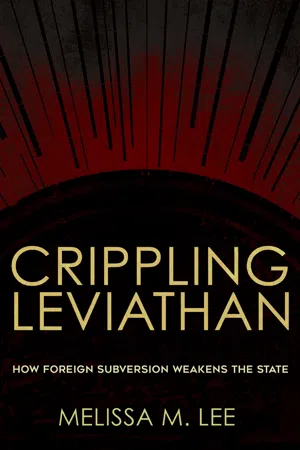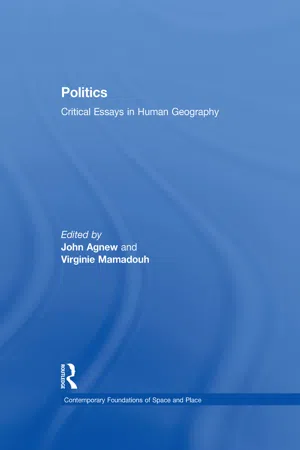Geography
Disintegration of States
The disintegration of states refers to the process by which a political entity breaks apart or loses its ability to govern effectively. This can occur due to factors such as internal conflict, economic instability, or ethnic and cultural divisions. The disintegration of states can have significant geopolitical and humanitarian implications, leading to issues such as refugee crises and regional instability.
Written by Perlego with AI-assistance
Related key terms
3 Key excerpts on "Disintegration of States"
- eBook - ePub
Crippling Leviathan
How Foreign Subversion Weakens the State
- Melissa M. Lee Desfor(Author)
- 2020(Publication Date)
- Cornell University Press(Publisher)
A number of scholars have argued that the state faces severe challenges administering and controlling territory in places with mountainous physical geography or unfavorable political demography. 25 These factors, however, are static (in the case of physical geography) or slow moving (in the case of political demography); they may explain initial levels of state weakness, but cannot easily explain temporal variation. A separate stream of scholarship has thus examined societal divisions, state-society relations, and intra-elite competition as explanations for statebuilding success. 26 A third set of domestic explanations, drawn from the literature on civil war, argues that grievance, economic inequality, and political exclusion promote resistance to state authority and make state consolidation more challenging. 27 Some grievances may be the product of historical legacies such as colonial borders, but in other cases are the consequence of conscious political decisions to marginalize or exploit segments of the population. 28 Studies of civil war onset have done much to advance our understanding of the determinants of large-scale political violence. Yet civil war and state failure are symptoms, not causes, of incomplete state consolidation. Nor are these the only symptoms; the failure to exercise authority need not manifest only as civil war. One need only look to the unrecognized proto-states inside the juridical borders of Somalia, Georgia, and Moldova to find examples of territory outside the authority of the central state but nonetheless without political violence - eBook - ePub
Politics
Critical Essays in Human Geography
- Virginie Mamadouh, John Agnew(Authors)
- 2017(Publication Date)
- Routledge(Publisher)
meanings of state boundaries. Territories may then have different relations with each other through their border areas, along a continuum stretching from alienated borderlands through to completely integrated borderlands (Martinez, 1994). As far as the effects of interdependence and integration inside states are concerned, this means that new voices will arise to articulate their interests. Much recent research in the field of IR has concentrated on the need to identify the political identities and social groupings which have been previously effectively suppressed by the hegemony of states (Minhha, 1996; Shapiro and Alker, 1996).Fragmentation resulting from self-government in ‘fourth world’ nations (Nietschmann, 1994; Griggs and Hocknell, 1995) could also result in an increase, rather than decrease, in the number of territorial, and perhaps new state, boundaries. Processes of conflict resolution, euphemistically labelled peace processes, bring about new lines of separation and physical barriers as conflicting nations retreat into their own territorial compartments. Conflict resolution is, more often than not, characterized by separate, rather than shared, spaces (Harbottle, 1994; Williams, 1994; Newman, 1996a; 1996b).The contemporary world is thus characterized by both diverging social, political and economic processes and very different interpretations of what they mean. Sociologist Oommen (1995) argues that the world we live in is characterized simultaneously by endisms (the end of history, geography, nature, ideology), postisms (postmodern, postindustrial, postcapitalist) and heyondisms (beyond the nation-state, beyond the cold war), and that these developments signify contradictory trends and tendencies. If endisms indicate a world without boundaries, postisms announce the emergence of fresh boundaries and beyondisms allude to the elongation of boundaries. Concomitantly, there is a set of newisms, - eBook - ePub
Political Change and Territoriality in Indonesia
Provincial Proliferation
- Ehito Kimura(Author)
- 2013(Publication Date)
- Routledge(Publisher)
This intellectual trajectory on territoriality was an important step forward in that it recognized the discontinuous nature of the modern state system and its potential erosion. Overwhelmingly this perspective saw forces such as Europeanization and globalization as fundamentally weakening states, trivializing boundaries, and undermining territorial sovereignty. Though the state formation and the state erosion perspectives differed in many ways, they did share the tendency to link territoriality to the level of the nation-state. A third trajectory of scholarship has helped to chip away at this trend.This third perspective actually countered the premise of weakening territoriality in an era of globalization. According to these scholars notions of territorial “unbundling” or “deterritorialization” were problematic in their simplistic depiction of changes occurring in the world. As the early projections of the sweeping impact of globalization abated, these scholars observed that states and territoriality remained remarkably resilient. The changes taking place were not that of “deterritorialization” but of reterritorialization (Kahler and Walter 2006 ).In making these arguments, scholars employed the concept of scale which highlights the way territories of differing size are nested within one another such as the global, national, and local levels (Delaney and Leitner 1997 ; Cox 1998 ). Because scales are malleable and dynamic, territoriality can then move upwards and downwards along the scale. Globalization is thus not destroying territory but rather rescaling it upwards to the supra-national level and downwards to the sub-national level. It is leading not to deterritorialization of the state, but rather to its denationalization (Brenner 1999 ). Said differently, rather than an unbundling of territory, there has been a process of rebundling , for example, upwards to the European level (Ansell and Palma 2004 ). In this sense, what is emerging today is a world where territory and authority are more fragmented, and not wedded to strict national territorial boundaries (Ansell and Palma 2004
Index pages curate the most relevant extracts from our library of academic textbooks. They’ve been created using an in-house natural language model (NLM), each adding context and meaning to key research topics.


